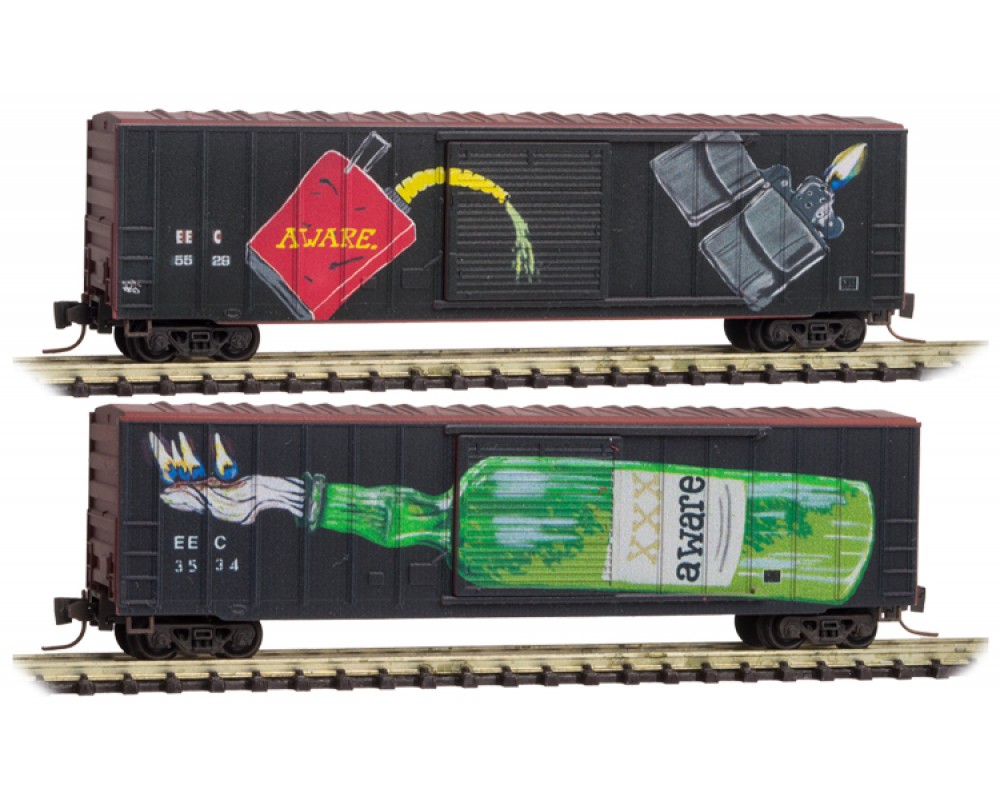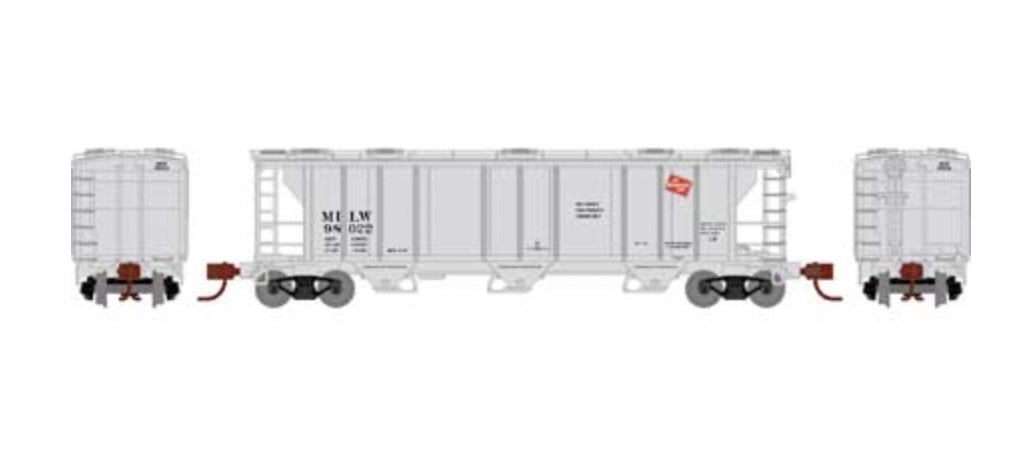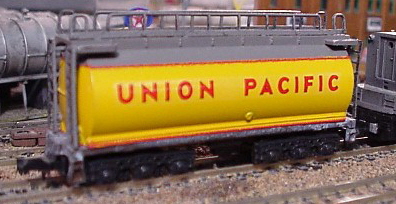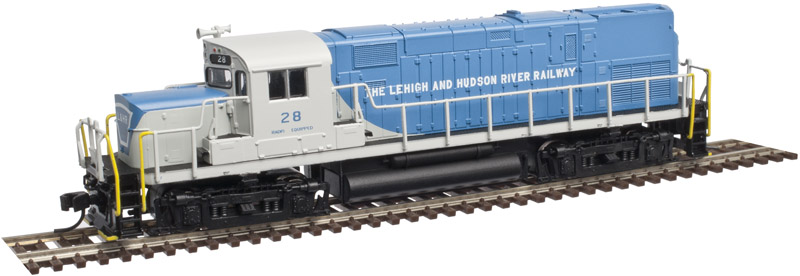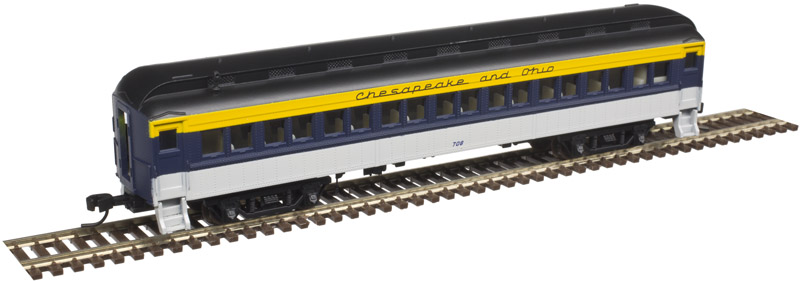Prototype History: While the 40-foot boxcar was a standard design, and it did come in different setups depending on the type of freight being transported, it was not large enough for efficient mass commodity transportation. The 50-foot boxcar made its first appearance in the 1930s and steadily grew in popularity over the years, which further improved redundancies by allowing for even more space within a given car. Today, the 50-footer remains the common boxcar size. After the second world war ended, and steel became once again readily available, steel became the go-to choice for construction of boxcars. Pullman Standard and ACF were some of the most prolific builders of these cars.
These cars came in many variations. For instance, double-doors became practical for large/wide loads, end-doors useful for very large lading such as automobiles, and interior tie-down equipment was helpful in keeping sensitive products from being damaged in-transit. In 1954 the Santa Fe developed its "Shock Control" (and later "Super Shock Control") technology for new boxcars with upgraded suspension systems to further improve the ride-quality and reduce the chance of damaging freight.
In the 1960s, the flush, "plug" style sliding door was introduced as an option that provides a larger door to ease loading and unloading of certain commodities. The tight-fitting doors are better insulated and allow a car's interior to be maintained at a more even temperature.
These cars came in many variations. For instance, double-doors became practical for large/wide loads, end-doors useful for very large lading such as automobiles, and interior tie-down equipment was helpful in keeping sensitive products from being damaged in-transit. In 1954 the Santa Fe developed its "Shock Control" (and later "Super Shock Control") technology for new boxcars with upgraded suspension systems to further improve the ride-quality and reduce the chance of damaging freight.
In the 1960s, the flush, "plug" style sliding door was introduced as an option that provides a larger door to ease loading and unloading of certain commodities. The tight-fitting doors are better insulated and allow a car's interior to be maintained at a more even temperature.
Road Name History: 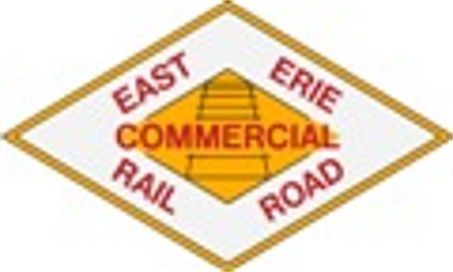 The East Erie Commercial Railroad is a single-track, standard-gage, electrically operated railway, located within the State of Pennsylvania. The main line extends northeasterly from Erie to near Harborcreek, including a line entirely around the plant of the General Electric Company. The main line mileage aggregates 6.726 miles. The carrier also owns and uses 3.632 miles of yard tracks and sidings, making a total of 10.358 miles of all tracks. The carrier grants trackage rights to the General Electric Company over a portion of its railroad.
The East Erie Commercial Railroad is a single-track, standard-gage, electrically operated railway, located within the State of Pennsylvania. The main line extends northeasterly from Erie to near Harborcreek, including a line entirely around the plant of the General Electric Company. The main line mileage aggregates 6.726 miles. The carrier also owns and uses 3.632 miles of yard tracks and sidings, making a total of 10.358 miles of all tracks. The carrier grants trackage rights to the General Electric Company over a portion of its railroad.
The EEC was incorporated October 17, 1907, under general laws of Pennsylvania, for the purpose of constructing, maintaining, and operating a railroad for public use, principally to serve the General Electric Company. The date of organization was October 19, 1907. A supplemental charter dated January 25, 1910, was granted under the same general laws of Pennsylvania.
That portion of the main line of the EEC known as the "Loop" was constructed for it by the General Electric Company in connection with the building of its plant. Work was begun on October 22, 1907, but the records do not indicate date of completion. Commercial operation was begun in 1911. Construction of the Eastern Division, extending from Franklin Road to Harborcreek Township, about 4 miles, was begun about July 1, 1915. Contracts were made with the General Electric Company for the electric work at cost plus overhead and for the excavation and grading on force account basis, the balance of the work being done by carrier's own forces.

The EEC was incorporated October 17, 1907, under general laws of Pennsylvania, for the purpose of constructing, maintaining, and operating a railroad for public use, principally to serve the General Electric Company. The date of organization was October 19, 1907. A supplemental charter dated January 25, 1910, was granted under the same general laws of Pennsylvania.
That portion of the main line of the EEC known as the "Loop" was constructed for it by the General Electric Company in connection with the building of its plant. Work was begun on October 22, 1907, but the records do not indicate date of completion. Commercial operation was begun in 1911. Construction of the Eastern Division, extending from Franklin Road to Harborcreek Township, about 4 miles, was begun about July 1, 1915. Contracts were made with the General Electric Company for the electric work at cost plus overhead and for the excavation and grading on force account basis, the balance of the work being done by carrier's own forces.
Brand/Importer Information: Micro-Trains Line split off from Kadee Quality Products in 1990. Kadee Quality Products originally got involved in N-Scale by producing a scaled-down version of their successful HO Magne-Matic knuckle coupler system. This coupler was superior to the ubiquitous 'Rapido' style coupler due to two primary factors: superior realistic appearance and the ability to automatically uncouple when stopped over a magnet embedded in a section of track. The success of these couplers in N-Scale quickly translated to the production of trucks, wheels and in 1972 a release of ready-to-run box cars.
Micro-Trains Line Co. split off from Kadee in 1990 to form a completely independent company. For this reason, products from this company can appear with labels from both enterprises. Due to the nature of production idiosyncrasies and various random factors, the rolling stock from Micro-Trains can have all sorts of interesting variations in both their packaging as well as the products themselves. When acquiring an MTL product it is very important to understand these important production variations that can greatly enhance (or decrease) the value of your purchase.
Micro-Trains Line Co. split off from Kadee in 1990 to form a completely independent company. For this reason, products from this company can appear with labels from both enterprises. Due to the nature of production idiosyncrasies and various random factors, the rolling stock from Micro-Trains can have all sorts of interesting variations in both their packaging as well as the products themselves. When acquiring an MTL product it is very important to understand these important production variations that can greatly enhance (or decrease) the value of your purchase.
Item created by: petecduffy on 2019-08-31 12:36:23
If you see errors or missing data in this entry, please feel free to log in and edit it. Anyone with a Gmail account can log in instantly.
If you see errors or missing data in this entry, please feel free to log in and edit it. Anyone with a Gmail account can log in instantly.


